The copper issues dated 1768 and 1769
Official issues of copper coinage in Mexico were decidedly unsuccessful, partly because of the cost of production and mainly due to the opposition of the private producers of tlacos. The first official issue was the copper maravedis of Carlos and Joanna.
1768
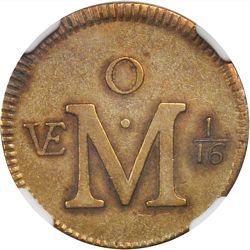
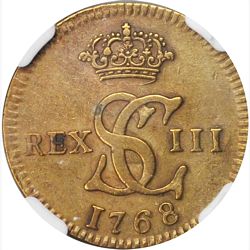
KM-PnA1 1/16 Real (2 Marivedis) (Stack’s-Bowers Baltimore Auction, November 2015, lot 39359)
On the obverse, the denomination is 1/16 of a real, the mint Mo in the centre and on the left the symbol "VE", an abbreviation for vellón (copper with some silver) or "vale" (for its value). On the reverse is the emblem of Charles III, preceded by the Latin expression "REX", the Roman numeral and the year.
In the middle of the eighteenth century Agustín Coronas y Paredes, of the Holy Office of the Inquisition of Seville, after his stay in Mexico proposed the manufacture of an official small coin, to counter the damage done to the Mexican people due to the variety and restricted use of tlacos of shops and pulquerías. In 1767 he managed to meet with Charles III to explain his motives and the monarch accepted what was said.
On 11 May 1768 the Marquis de Croix, Viceroy of New Spain, agreed the previous proposal for the issue of a copper coin in New Spain. However, the Court that had been formed to analyse the proposal rejected it in May 1768. In this process the Mint amended 8 proof coins of 1/16 of the Real or pilons dated in such year. The pieces were entrusted to the Superintendent of the Mint, Pedro Núñez de Villavicencio, who also expressed his displeasure for such coins, being unviable due to the small denomination, he stated that with inconveniences in weight, volume, and the cost of manufacture is highMauricio Fernández Garza and Gabriel Gómez Saborio, Las Monedas Particulares Mexicanas. 2018, Monterrey, Nuevo León..
1769
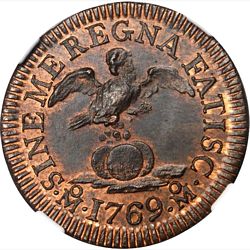
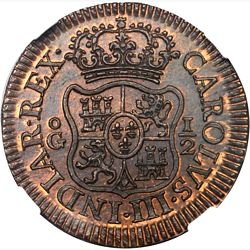
KM-PnC1; Cal-type-194#1871. 1/2 Grano. (Stack’s-Bowers NYINC Auction, January 2014, lot 1363)
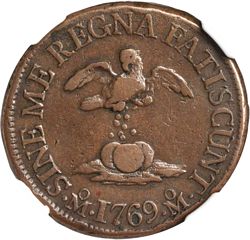
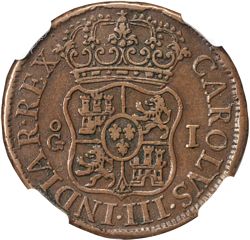
(KM PnD1 grano 1769 (Stack’s Bowers Baltimore auction, November 2015, lot 39360)
The Latin inscription SINE ME REGNA FATISCUNT translates as ‘without me the kingdoms decay’. The eagle (not necessarily on a cactus, but representing the Spanish Crown is distributing coins (?) to three globes, representing old Spain (Europe), New Spain (viceroyalties in America) and Eastern Spain (Philippines).
Go is thought to be grano (grain) with the value of these coins being "one grain" and "half grain." This "grain" was intended to be issued to replace the tlaco, copper coins that were equivalent to an eighth of a real. The grain was equivalent to 1/12 of a real and could only circulate in New Spain. It is suggested that the use of "grain" was inspired by the successful and accepted copper coin "grana" of the kingdoms of Naples and Sicily, which in 1759 issued such coins by order of Charles III (the same reigning monarch at the time of the manufacture of these samples).
It is suggested that these are patternsNeil Utberg in his Numismatic Sidelines of Mexico (1965) quotes José Toribio Media and Ramón Vidal Quadras, and suggests that they were created by students in schools of engraving and metal handling to demonstrate their handling of engraving and metal carving, as samples, resembling several medals of the nineteenth century. or, very possibly and more likely, a rare and short lived issue intended for circulation in Mexico rather than patterns. The first piece of evidence is that no other Spanish Colonial patterns bear the “Mo” mintmark. For instance, the 1729 pattern for the pillar 8 Reales bears the mintmark of Madrid. Also, all other Charles III patterns were submitted directly from Spain and either bearing the Madrid mintmark or a large “N” in place. It is also interesting to note that the Charles III copper series is nearly always found in well circulated condition, often corroded. This is not typical of a coinage that was produced for pattern purposes, but more indicative of a currency intended for circulation.
In a document of 24 December 1769[text needed] located in the Archivo General de la Nación AGN, Correspondencia de Virreyes, Vol. 16) the Viceroy reports sending six sample coins minted in accordance with the Real Cedula (Royal Ordinance) of 27 October 1767 which authorized and instructed the introduction of copper coinage in the Viceroyalty in order to replace the coinage known as tlacos (locally and privately issued tokens) valued at 1/8 real per tlaco. Most interestingly, the letter indicates that the larger coins would be valued at 1 Grano or 1/12 Real each, that the coins’ circulation would be limited to the four kingdoms of the Viceroyalty: namely Nueva España, Nueva Galicia, Nueva Viscaya and Nuevo León, that the coins carry on their obverse a shield representing said four kingdoms, with the letters “G” (and) “O” to the shield’s right meaning Grano, and the numerals “1” and “1/2” for the larger and smaller coins respectively.
The known pieces are a perfect match for this description. In addition, the Latin inscription INDIAR.(UM) REX on the obverse is correct for a coinage intended for circulation only in part of the Indies (and not mainland Spain) while the inscription on the reverse SINE ME REGNA FATISCUNT (“without me the kingdoms decay”) can now safely be interpreted as a reference to the purported benefits of this new copper coinage for the aforementioned four kingdoms’ benefit: the flying eagle on that same side is disseminating copper coins to the three globes or dominions, which probably represent respectively mainland Spain, its American possessions and its possessions in the Orien Carlos Jara, "Notes on the Mexican Grano issues dated 1769".
Luciano Pezzano Luciano Pezzano, “Dos enigmáticas piezas coloniales mexicanas”, Revista del Círculo Filatélico y Numismático San Francisco no. 49, 2011, Córdoba, Argentina has pinpointed the punch link of the crowns between the “1/2 Go” and the pillar 1 Real coins and between the “1 Go” and the pillar 2 Reales respectively.
Perhaps the reason for its short lived nature is that Charles III hired Tomas Francisco Prieto to superintend all of the mints in his kingdom, in order to unify the coinage. Prieto designed the new portrait coinage for Charles III and supplied all of the mints with patterns dated 1770 that were produced in Spain. The unification of the New World mints seems like a logical reason to do away with a subsidiary copper coinage that was being produced by only one of the mints the previous year.
Other theories include the possibility of it being a pattern struck at Mexico City and submitted back to Spain for consideration as a circulation issue for the Philippines, since this territory requested remittances of currency from Mexico at that time.
